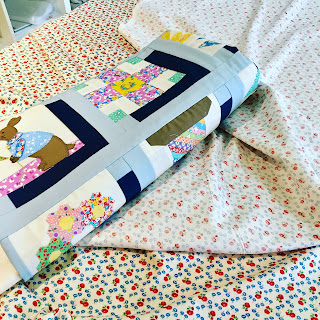The original reason for the "shadows" was that my blocks were not all exactly the same size (I really need to work on accuracy). This allowed me to fudge a little.
I'm so happy with it!




Striped binding is the best!






Labels: the splendid sampler
By now you hopefully have your color ranges determined and your fabric collected. If not, don't stress. I have a feeling there's going to be a LOT of catching up happening throughout the year.
So, how are going to keep track of all of this?
Here's what I came up with so far:
I started off by writing the temperature range assigned to a specific fabric in the selvedge of each fabric with a Micron pen. You can use any marking tool, since this won't become part of your quilt.
After doing that, I mulled it over a bit and realized that, even though that was a good idea, hunting down fabrics by checking their selvedges could possibly be time consuming.
Soooo....I drew up a little fabric key. If you'd like it, you can download it here.
I then wrote my fabric ranges down, cut a little sliver of each applicable fabric, and glued them on there. I may have to redo this, since I was obviously not having a very good day when I did this (and I couldn't find the white-out). The numbers to the left of the fabric bits are the SKU numbers, so they're not all that important anyway.
I think this will allow me to find the correct fabric for each block quite easily.
And all of it is in this handy dandy Sterilite tote from Target:
Next Friday I will have the very first Link List up here so we can share our progress! Also, a very big part of this will probably be happening on Instagram.
Oh and, if you're still mulling over your fabric choices, lovely Rainbow Bella Bundles are still available in the Etsy store.
Last week I talked about choosing colors for the Temperature Quilt. Today I'll share a few of my thoughts regarding design.
I just realized it will take me many, many posts to catch you up on all I've been up to. I'd have to go back to somewhere in 2017.
With that in mind, I think I'll just post a couple of pics now and maybe a couple more in the couple of days. And vow to be better at sharing in 2019.
Rail Fence Quilt 1/18
This is my "Spring Retreat Quilt"
Mod Ornaments Runner 1/18
I'm using it for the first time this Holiday season and, even though I wasn't all that enamored with it when I made it, it's grown on me.
In my effort to revive this blog (Don't you think blogging should make a big comeback?), I'm going to post some updates on what I've been working on this past year.
First, my Sue Spargo Folk-Tails quilt. I was really hoping to get it done by December 17th (which would have been 1 year since I started), but it obviously did not happen. I'll get there eventually.


Labels: Folk Tails quilt, Sue Spargo, wool applique
Oh my goodness! I am blown away by the number of people who have signed up to join me on this adventure! And now I’m feeling a LOT of pressure to deliver!

In this quilt along, we will work with two colors for each day, and 365 separate blocks.
SO WHERE DO WE START?
You will need to make three decisions before you begin:
1 - what block type and what size
2 - how many and which colors
3 - how many and which temperature ranges
Block type and size:
In order to achieve the effect we're looking for, you will have to use blocks that can be made in two colors. Examples include: half square triangles, flying geese, square-in-a-square or, what I'm planning (yes, I'm nuts), a circle appliqued onto a background square.
I actually made a little block just to see if this is a feasible idea. I think it can be done.
 OK, here we go! I realized the other day that most of my quilt alongs are started because I need the motivation to actually complete a project.
OK, here we go! I realized the other day that most of my quilt alongs are started because I need the motivation to actually complete a project.
When I was reading up on how to host a quilt along, one of the first requirements was to actually make the quilt. Hmmmm...
WARNING: This is a rather long post, but please bear with me.
Realizing that 24 colors may be a whole lot to get together for the temperature quilt, I redrafted my prototype using only 12 colors.
This is the 24 color version: